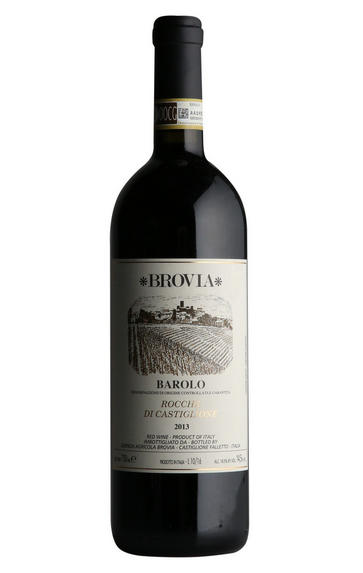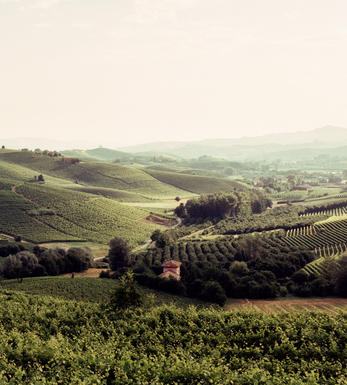
2017 Barolo, Rocche Castiglione, Brovia, Piedmont, Italy

Critics reviews
Castiglione Falletto. 'As soon as the fermentation ends, we take a couple of days to decide if we prolong the wine's period on the skins. Some years are slow; other years are faster. In 2017 you had minimal maceration because it depends on the year. You can only prolong the maceration based on the quality of the tannins. In 2017 we did very few pumping overs because the tannins should always balance the wine. The Rocche di Castiglione seems complete and delicious, but it should get three more years.'
Youthful mid-ruby. Lifted perfumed raspberry fruit nose but still a little closed. Great purity of fruit. Crushed raspberry fruit palate with juicy acidity and fine, powdery tannins. Very elegant and complete and has a great aromatic build-up of fresh red fruit on the finish.
Drink 2022 - 2032
Walter Speller, JacisRobinson.com (December 2020)
A release of about 5,000 bottles, the Brovia 2017 Barolo Rocche di Castiglione offers a very elegant take on a wild and hot vintage that was only sometimes easy to tame. The wine's aromatic profile can be described as ripe because you get a generous dose of fragolino di bosco (wild strawberry), peach and orange blossom. Like the Villero, that ripeness is mitigated by the pretty mineral note that frames the bouquet. That dusty crushed limestone is more prominent in the case of the Rocche di Castiglione. However, the mouthfeel is a touch more compact and slenderer in the case of this wine. The tannins are silky and fine, but it would be nice to return to this bottle in five years or more when the wine has had the chance to flesh out further.
Drink 2024 - 2038
Monica Larner, Wine Advocate (June 2021)
This has very pretty sweetness of fruit to it, with dried strawberries and cherries, walnuts, and light cocoa powder. It’s medium-to-full-bodied with creamy tannins and a subtle finish. Better in three or four years.
Try after 2025
James Suckling, JamesSuckling.com (July 2021)
Camphor, star anise, tobacco and underbrush are just some of the aromas you'll find on this stunning red. Full-bodied and elegantly structured, the savory palate doles out ripe Marasca cherry, rasberry compote, baking spice and licorice set against youthfully assertive, noble tannins. Give it time to fully develop.
Drink 2027 - 2037
Kerin O'Keefe, Wine Enthusiast (September 2021)
About this WINE

Azienda Agricola Brovia
Azienda Agricola Brovia is situated in Castiglione Falletto, Piedmont, northwest Italy. The winery has a rich history dating back to the 19th century when the family started cultivating vineyards in the area. Today, it’s owned and operated by the Brovia family’s third generation, consisting of sisters Cristina and Elena Brovia, along with Elena’s husband, Alex Sanchez.
The estate covers approximately 14 hectares (35 acres) of vineyards, primarily planted with Nebbiolo, the grape variety responsible for producing Barolo wines. Additionally, they grow smaller amounts of other local grape varieties, such as Dolcetto and Barbera. The vineyards are managed with great care and respect for traditional viticultural practices, including organic and sustainable farming methods.
Brovia is known for producing high-quality, terroir-driven wines that reflect the unique characteristics of their vineyard sites. They follow a traditional approach to winemaking, combining modern techniques with respect for the region’s winemaking heritage. The wines undergo extended maceration and ageing in large oak casks to develop complexity and structure while preserving the elegance and finesse that Barolo is famous for.

Barolo
Located due south of Alba and the River Tanaro, Barolo is Piedmont's most famous wine DOCG (Denominazione di Origine Controllata e Garantita), renowned for producing Italy's finest red wines from 100 percent Nebbiolo.
Its red wines were originally sweet, but in 1840 the then extant Italian monarchy, the House of Savoy, ordered them to be altered to a dry style. This project was realised by French oenologist Louis Oudart, whose experience with Pinot Noir had convinced him of Nebbiolo's potential. The Barolo appellation was formalised in 1966 at around 1,700 hectares – only a tenth of the size of Burgundy, but almost three times as big as neighbouring Barbaresco.
Upgraded to DOCG status in 1980, Barolo comprises two distinct soil types: the first is a Tortonian sandy marl that produces a more feminine style of wine and can be found in the villages of Barolo, La Morra, Cherasco, Verduno, Novello, Roddi and parts of Castiglione Falletto. The second is the older Helvetian sandstone clay that bestows the wines with a more muscular style. This can be found in Monforte d'Alba, Serralunga d'Alba, Diano d'Alba, Grinzane Cavour and the other parts of Castiglione Falletto. Made today from the Nebbiolo clones Lampia, Michet and Rosé, Barolo has an exceptional terroir with almost every village perched on its own hill. The climate is continental, with an extended summer and autumn enabling the fickle Nebbiolo to achieve perfect ripeness.
Inspired by the success of modernists such as Elio Altare, there has been pressure in recent years to reduce the ageing requirements for Barolo; this has mostly been driven by new producers to the region, often with no Piedmontese viticultural heritage and armed with their roto-fermenters and barriques, intent on making a fruitier, more modern style of wine.
This modern style arguably appeals more to the important American market and its scribes, but the traditionalists continue to argue in favour of making Barolo in the classic way. They make the wine in a mix of epoxy-lined cement or stainless-steel cuves, followed by extended ageing in 25-hectoliter Slavonian botte (barrels) to gently soften and integrate the tannins. However, even amongst the traditionalists there has been a move, since the mid-1990s, towards using physiologically (rather than polyphenolically) riper fruit, aided by global warming. Both modernist and traditional schools can produce exceptional or disappointing wines.
Recommended traditionalist producers:
Giacomo Borgogno, Giacomo Conterno, Bruno Giacosa, Elio Grasso, Marcarini, Bartolo Mascarello and Giuseppe Mascarello.
Recommended nmdernist producers:
Azelia, Aldo Conterno, Luciano Sandrone, Paolo Scavino and Roberto Voerzio

Nebbiolo
Nebbiolo is the grape behind the Barolo and Barbaresco wines and is hardly ever seen outside the confines of Piedmont. It takes its name from "nebbia" which is Italian for fog, a frequent phenomenon in the region.
A notoriously pernickety grape, it requires sheltered south-facing sites and performs best on the well-drained calcareous marls to the north and south of Alba in the DOCG zones of Barbaresco and Barolo.
Langhe Nebbiolo is effectively the ‘second wine’ of Piedmont’s great Barolo & Barbarescos. This DOC is the only way Langhe producers can declassify their Barolo or Barbaresco fruit or wines to make an early-drinking style. Unlike Nebbiolo d’Alba, Langhe Nebbiolo can be cut with 15% other red indigenous varieties, such as Barbera or Dolcetto.
Nebbiolo flowers early and ripens late, so a long hang time, producing high levels of sugar, acidity and tannins; the challenge being to harvest the fruit with these three elements ripe and in balance. The best Barolos and Barbarescos are perfumed with aromas of tar, rose, mint, chocolate, liquorice and truffles. They age brilliantly and the very best need ten years to show at their best.


Buying options
Add to wishlist
Description
Castiglione Falletto. 'As soon as the fermentation ends, we take a couple of days to decide if we prolong the wine's period on the skins. Some years are slow; other years are faster. In 2017 you had minimal maceration because it depends on the year. You can only prolong the maceration based on the quality of the tannins. In 2017 we did very few pumping overs because the tannins should always balance the wine. The Rocche di Castiglione seems complete and delicious, but it should get three more years.'
Youthful mid-ruby. Lifted perfumed raspberry fruit nose but still a little closed. Great purity of fruit. Crushed raspberry fruit palate with juicy acidity and fine, powdery tannins. Very elegant and complete and has a great aromatic build-up of fresh red fruit on the finish.
Drink 2022 - 2032
Walter Speller, JacisRobinson.com (December 2020)
wine at a glance
Delivery and quality guarantee